| Columns Retired Columns & Blogs |
Figure 6 is incorrect, it shows the waterfall plot instead of the vertical response.

Indeed! The voice of my full-range system in the living room is a pair of B&W 808 speakers, ca late 1980s. The smaller-scale system at our house upstate features a pair of B&W 805 D2s. So, outside of my mastering studio, most of the music I listen to is through Bowers & Wilkins speakers. I am accustomed to and enjoy B&W sound and styling.
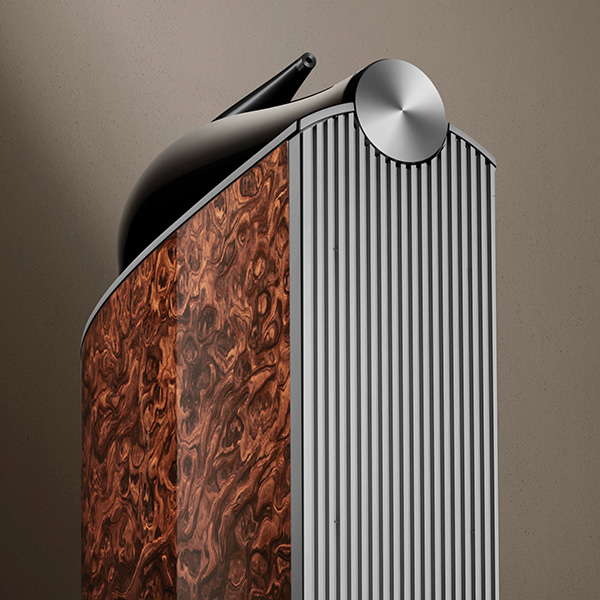
A whole lotta speaker, with a heritage
Before the introduction of the Signature, the standard 801 was B&W's top-line offering; "D4" indicates the design's fourth generation. The Signature Editions are occasional special releases featuring upgrades both functional and aesthetic. B&W describes Signature speakers as "the culmination of Bowers & Wilkins's enduring dedication to performance and elegance."
Compared to the standard 801 D4, the Signature Edition uses heavier bracing, upgraded bass motor systems, a flared metal, downfiring port, and extra high-quality parts in the crossover networks (footnote 1). On the aesthetic side, there's a choice of two high-end finishes: "Midnight Blue Metallic" and "California Burl Gloss." The pair I enjoyed in my living room for two months were the former: a rich, deep, dark blue. They scored high with the Wife Acceptance Factor (WAF), though most importantly, she really dug the sound.
B&W speakers have appeared often in this magazine (footnote 2), but the last time we reviewed the company's flagship speakers was 2011; that was Kal Rubinson's review of the 800 Diamond (footnote 3). The company has a long history, dating from the WWII-era British MI6 service of John Bowers and Roy Wilkins. The two friends were amateur radio enthusiasts and, following VE Day, they started a radio and audio shop in Bowers's hometown of Worthing. Bowers was a classical music fan, and he wasn't satisfied with the sound of 1950s loudspeakers. He modified existing speakers, made custom units for the shop's customers, and gained a reputation among British audiophiles. One of his customers, an opera singer, bequeathed him enough money to go into speaker design full-time, leaving Wilkins to run the shop. Wilkins's son Paul was the first director of UK sales (footnote 4).
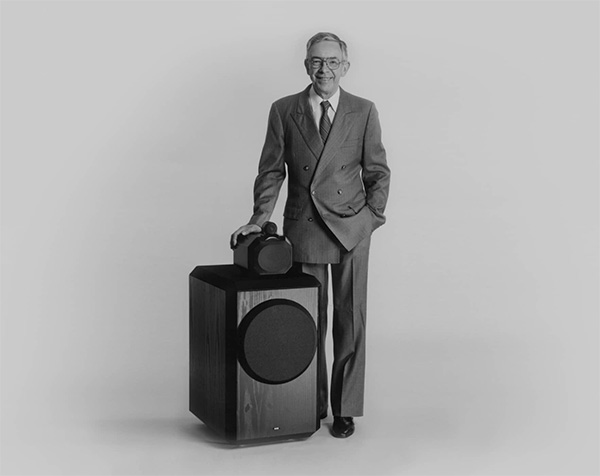
Bowers was a science and measurements man, and to this day the company retains its science-based design philosophy. Over the years, his approach centered on keeping the bass, midrange, and treble drivers apart, in separate chambers within non-resonant cabinets. That approach continues today.
I asked Andy Kerr, B&W's director of product marketing & communications: Does the current production B&W model 801 have any resemblance or share any design characteristics with the first 801 built in 1979? (footnote 5)

"Absolutely," he replied. "When John Bowers and his team were first working on the original 801, they were inspired by the success of an earlier model, the DM7. [The] DM7, released in 1977, had taken the HF drive unit and mounted it in its own enclosure—we call it 'Tweeter on Top'—with great success. This dramatically reduced the audible impact of the cabinet on the drive unit: the cabinet baffling effect. The original 801 simply took that premise and applied it to the midrange enclosure, too. It was the first 'three-box' speaker we had developed, with dedicated enclosures for the low, medium, and high frequencies. Today's 801 D4 Signature has evolved in many ways, but its essence is just the same.
"The 801 was also designed to fulfill a dual role. It had to be accurate enough to be used as both an audiophile's ideal home reference design and also as a monitor loudspeaker in recording studios." Famously, B&W loudspeakers have long been used at Abbey Road Studios, which, after many years using B&W speakers in studio, established a formal partnership with B&W in 2017.
Kerr continued: "The latter requirement meant it also had to be sufficiently compact. ... That's because there's seldom a lot of space behind the console in a recording studio! In addition, studio engineers often move speakers around to accommodate their clients, and they wouldn't take too kindly to a speaker that required a forklift to make that possible. Even today, while the 801 D4 Signature is hardly a small speaker, it's not as large as the flagship rivals from some of our competitors.
"The original 801 was designed with a flexible midrange cone and quickly moved to adopt pistonic HF and LF drive units, in the early days using materials such as aluminum and Cobex. Today's 801 D4 Signature is no different, although the material types have evolved, ie, to Diamond, Continuum, Aerofoil.
"And finally, even the earliest 801 had the most inert cabinet we could make at the time. By 1987, although it looked similar to earlier models, it had adopted Matrix bracing—internal reinforcing structures—and its head assembly was heavily reinforced. Again, today's 801 D4 Signature is no different—just better."
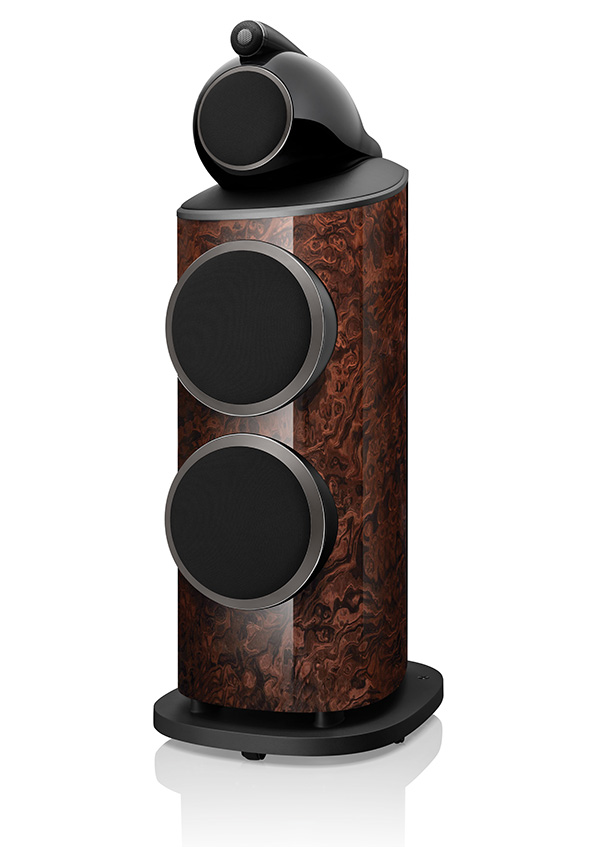
I asked Kerr to put in layman's terms: What are the signature technologies in the D4 version of B&W's 800 series, and how do they apply to enjoyment of music in a real-world listening room? He mentioned four key principles. "Keep the cabinet as mechanically quiet as possible, give [the drivers] the most acoustically open structure possible, ensure every drive unit is as 'clean' and low in distortion as possible, and minimize losses through the signal path.
"How does all that apply to your enjoyment of music? Great question. We don't measure or aim for a certain target in-room response. We're not tuning to a 'curve.' We develop the best engineering platform we can, and then we tune it so that we, as a group, can forget that we're listening to a pair of speakers and just get on with enjoying the listening experience. So, the target is this: Can you close your eyes and convince yourself, even for a split second, that the recording you're listening to is actually a real performer or group of performers in the room with you? If we manage to achieve that effect, we're happy. I've always said, no one buys loudspeakers to listen to loudspeakers. They buy them to listen to music."
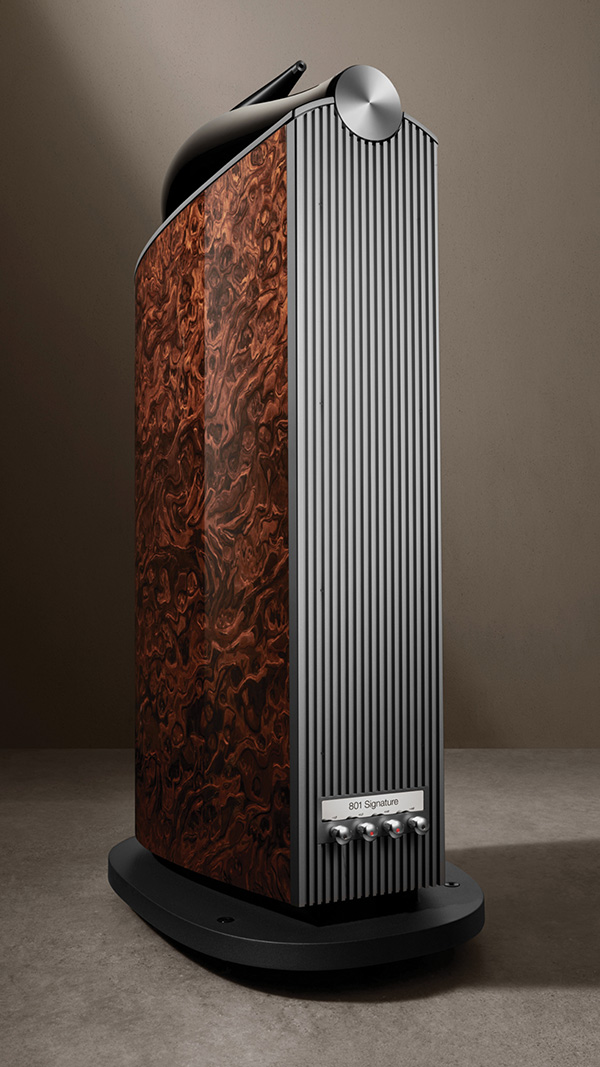
How are these objectives achieved? The 801 D4 Signature is made mostly of aluminum, with a "reverse-wrap," multi-ply wooden shell. The woofer body is topped with an aluminum plate covered in fine leather. The midrange and tweeter chambers are all aluminum. The Diamond tweeter is made from synthetic diamond, an implementation of the "hard tweeter" concept employed by other loudspeaker companies; The idea is to maintain true pistonic operation in the audible range and raise any breakup effects—ringing or resonance—way beyond audible frequencies. Kerr told me the D4's tweeter breakup is above 70kHz. The tweeter features a longer housing to absorb more of the back wave. The midrange "Turbine Head" houses the 6" driver; the D4 version features an improved "spider" material, an open, flexible, yet stiff structure designed to reduce "secondary" output (B&W's words), which is also known as noise. The woofers fire forward and vent downward.

The 801's crossover networks (above) are bolted to the interior of the metal rear panel. The Signature version includes extra bypass capacitors and upgraded parts and wiring. Kerr said the woofers are fed from a third-order low-pass filter at 400Hz, and there's a second-order high-pass at 400Hz into the midrange driver. The higher-frequency crossover consists of a second-order low-pass to the midrange and a first-order high-pass to the tweeter, both at 4kHz.
On the rear-panel exterior are two sets of five-way binding posts, LF and HF, allowing biamping or biwiring. Heavy-gauge jumper wires are included in the box. I ran the speakers single-wired, using these jumpers.
Signature features
I asked Kerr to go deep about the differences between the 801 D4 Signature and the regular 801 D4, aside from a snazzier look and a price that's $12,000 higher. He obliged.
"The first focus is the cabinet. We've spent years looking at the impact of unwanted resonances moving through structures. We began by using a scanning vibrometer"—a laser-based device that precisely measures vibrations at any position on the cabinet—"and today we combine the data we get from that with a powerful simulation package called COMSOL Multiphysics. The aim is always to reduce unwanted excitation of structures or coloration of drive units as a loudspeaker operates. The 801 D4 Signature represents the pinnacle of our current knowledge in this area."

When the 800 D4 series was introduced in 2021, an aluminum top plate was employed. That top plate, Kerr said, made the structure much stiffer, but "it also had its own slight resonances." On the Signature model, holes are carved out of the top plate at strategic points, "which narrows the resonances in band and pushes them upwards in frequency." Those narrower, higher-frequency resonances are easier to damp, and this is accomplished using "carefully positioned Tecsound, a viscoelastic soundproofing and damping membrane." The same material was already employed in the turbine head and plinth. "The result is a significant reduction in unwanted mechanical output from the top of the cabinet, right in the critical area around the midrange cone. That has notable benefits for midrange openness and spaciousness.
"We've also revisited the port at the bottom of the speaker. On an 801 D4, the area around the port—which is a very substantial output—is critically braced with an aluminum plate, restoring stiffness to the cabinet to compensate for the large port aperture we have cut into it. In the 801 D4 Signature, we further stiffen the bottom of the speaker by replacing the plastic port ... with a cast-aluminum port flare. Essentially, that means the whole bottom section of the speaker is now aluminum. You'll hear this in lower port noise, quicker leading edges to bass transients, and more perceived 'punch.'
"The last mechanical change is to the grille mesh pattern on the tweeter. Back in 2015, we introduced a fixed steel grille mesh with an optimized grille pattern that provided an ideal combination of openness and strength. Unlike previous generations of 800, it was designed to be used fixed in place, not removed by the user. In 2023, we've introduced an updated and improved version of this grille mesh, which is as stiff as before but notably more open, allowing more energy from the HF into the room."
The engineers felt that with the 800 D4 series, the tweeter and the midrange driver were already optimized, but there was room for improvement with the woofer. The 801 D4 Signature "uses an improved motor system with a new top plate and midplate featuring an upgraded specification of steel that leads to lower current distortion in the motor, which leads in turn to a cleaner, more accurate bass presentation.
"We've improved the crossover with new bypass capacitors, which are doubled up across the board relative to the 801 D4. ... There are 16 in total. Essentially, the new caps help the main capacitor values to work at closer to peak efficiency, giving us more resolution and at the same time a welcome refinement to the overall tonality."
Finally, the cosmetics have been raised to a higher level. "We either have California Burl, a sustainably sourced Alpi veneer, engineered from real wood with very dramatic figuring and texture, or we have Midnight Blue Metallic, the same paint we use on our Nautilus. Both finishes are prepared to the highest of standards before receiving paint and/or lacquer, with the final surface preparation being done by 3000-grit sandpaper. California Burl has a total of 14 coats of lacquer. Midnight Blue Metallic has a combination of 11 coats of paint and lacquer. Midnight Blue Metallic is also trimmed in matching blue leather by Connolly," the company that provides interior leather to McLaren and other luxury car makers.
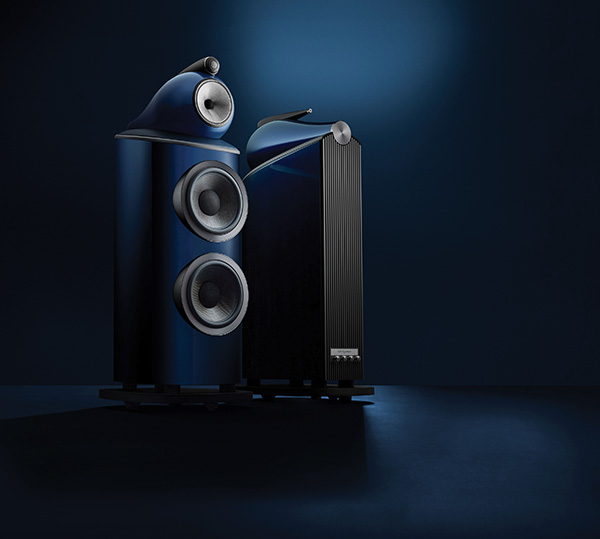
Getting the speakers in place
In early October, a pair of Midnight Blue Metallic 801 D4 Signatures arrived in two large cardboard boxes bound to a pallet, total weight: 600lb. Into the picture stepped David Woodward, owner of Home Media Designs in Ridgefield, Connecticut, a nearby Bowers & Wilkins dealer, and two strong-backed associates, Frank Silvi and P.J. Mihalick. The fellas arrived with an appliance dolly, designed to heft stoves and washing machines up flights of stairs, and some straps. They made short work of moving my 808s out of the way and putting the 801s roughly in place.
B&W packs these speakers in a clever four-piece box that holds together tightly but comes apart easily. A heavy plastic ramp is built in to the box to roll out the speakers, which are shipped with casters already installed. I kept the speakers on the casters until positioning was optimized.
I spent a couple of weeks running them in, loud and hard and soft and sweet, playing all kinds of music, internet radio—even using them as the world's most expensive TV speakers, all in the interest of loosening them up and getting them to their ideal operating condition. Over that time, I didn't hear much change in the top end or midrange, but the bass got bigger, especially deep bass. On J.S. Bach's Toccata, Adagio and Fugue, played by Virgil Fox on the direct-to-disc LP The Fox Touch Volume One (Crystal Clear Records CCS-7001), the famous growl and rumble of the biggest pipes in the former Crystal Cathedral was satisfyingly room-shaking after this multiday sound workout, whereas at first it sounded too constrained.
The speakers were located roughly where my larger-footprint 808s had been, but at this point, their sound didn't seem to fill the room as much. Was it just a matter of me adjusting to a modern, more pronounced tweeter, or did their position need adjusting?
Then appears a visitor
Longtime B&W rep Lucette Nicoll reached out to tell me that Peter Madueno, regional brand activator for Masimo Consumer, wanted to visit and make sure the speakers were set up and behaving optimally in my room and system. Peter arrived a few days later.
Madueno agreed that the 801 D4 Signatures sounded a bit bright, and he thought they should be projecting more deep bass into the room. He rolled the left speaker back against the wall and played a Jennifer Warnes cut, "Ballad of the Runaway Horse," a bonus track from the 20th anniversary reissue of Famous Blue Raincoat (16/44.1 FLAC, Shout!/Qobuz). He told me to listen to the bass: It should dip softer, grow louder, then fade softer again as he moved the speaker outward from the wall. Sure enough. He rolled the speaker back against the wall and told me to say when the bass was at peak loudness before starting to roll off again as the speaker rolled farther into the room. We identified that spot. Then he measured the distance from the rear of the speaker to the wall and moved the other one out by the same distance. Already, the sound was noticeably better, with a firmer, more detailed low end. The top-end energy and midrange detail, sparkle, and punch were retained. Then we worked on toe-in. Optimal placement ended up being about 18" out from the back wall, toed in about 10°, 9' between woofer centers, the listening seat about 10' out from the center.
Madueno's final task was to level the speakers and anchor them to my faux-wood floor with the rubber feet. We spent a few minutes fiddling with the threaded feet and the included tools, and there the speakers stood until the day they moved on.
Finally, weeks of serious listening
Now that I was happy with the placement of the speakers, it was time to get down to some critical listening.
Around the time the speakers arrived, I received prerelease copies of my latest Mercury Living Presence reissue: Los Romeros–The Mercury Masters (10 CDs, Decca 485 4015; footnote 6). This reissue project, which I produced and remastered, was great fun because the three Romero brothers—Celin, Pepe, and Angel—were enthusiastic participants. The team at Decca Classics did a great job with packaging and the booklet.
Footnote 2: John Atkinson reviewed the 804 D4, the smallest floorstanding B&W 800 series speaker, in December 2021. Kal Rubinson reviewed the floorstanding 702-S2 in April 2018.
Footnote 3: The 800 model was discontinued in 2011.
Footnote 4: Here is B&W's own version of their beginnings: tinyurl.com/BW-beginnings.
Footnote 5: See tinyurl.com/801-series-history.
Footnote 6: See tinyurl.com/Romeros-Decca, also available at Amazon and other music retailers; promo video here: youtube.com/watch?v=9y1MpKx_BLw.

JA: "The minimum EPDR values are 1.24ohms at 72Hz, 2.3ohms at 362Hz, 1.62ohms at 912Hz, and 1.82ohms at 10.6kHz. The 801 D4 Signature has one of the most current-hungry impedances I have encountered"
This to me says just as hard or even harder load than Wilson Alexia's, and the amps/ that were used (especially the Class-D) for this review I feel didn't do the speakers justice that they rightfully deserve.
Cheers George

... for driving such a low impedance load include the ($3,400) Rotel RA-1592 MKII and the ($5,800) Rotel Michi X3 Series 2. Either amp can generate a peak output power of over 1.7kW into a 1ohm load.
https://www.hifinews.com/content/rotel-ra-1592mkii-integrated-amplifier-lab-report
https://www.hifinews.com/content/rotel-michi-x3-series-2-integrated-amplifier-lab-report
In case a professional Stereophile reviewer needs something with a higher level of audiophile credibility, there's the ($12,500) Hegel H600, which is capable of a peak output power of 2.3kW into a 1ohm load.
https://www.hifinews.com/content/hegel-h600-network-attached-amp-lab-report
If that's still too inexpensive, then there is the ($65,000) D'Agostino MxV Integrated, which is capable of a peak output power of about 1.6kW into a 1ohm load.
https://www.hifinews.com/content/dagostino-mxv-integrated-integrated-amplifier-lab-report

It's more current that's needed than wattage, because they are 90db efficient, so even a 100w into 8ohm amp will do, so long as it can "almost" double down it's wattage to 4ohm, and "almost" double again down to 2ohm. These sort of amps are linear big & heavy, and usually bi-polar output stage, like Agostino, Gryphon, Halo, Krell etc etc.
Cheers George

... nearly 1ohm. A "100W into 8ohm" amp that can "double down" into such a load would need to be capable of about 800W into 1ohm. How many amps can do that?
The Benchmark amp used for the test could only manage 230W into 1ohm:
https://cdn.shopify.com/s/files/1/0321/7609/files/HFN_Mar_Benchmark_AHB2_Reprint.pdf
As noted above, the less expensive of the two Rotel amps could output over 1.7kW into 1ohm, and it weighs less than 40lbs. The more powerful Hegel amp weighs lesss than 50lbs.

JAs measurements confirming tipped up treble. The ripeness / warmth of a Gryphon might make that less noticeable.

As a NON audiophile friend once said when we talked about my set, he was curious about the (financial) damage: "for that money I can go to a lot of live concerts, then I really hear the music live and I am really present. How real can you have it?".
He also said "I can't hear your speakers", the biggest compliment a audiophile can get.
If you already have a Bugatti, you can definitely consider these speakers. Yes, yes, I know, these speakers are mainly intended to show, um... hear what they are capable of (in order to sell cheaper models better, yes, I know) but then I want to read about a direct comparison with for example the Focal Utopia or price-wise comparable Wilson Audio. Now I don't know anything yet (about something I'm not even considering).

... assuming that you have a good seat and the sound system, if it's a non-acoustic performance, is of high quality.
But, what if you can't get to any of the venues at which the artist you want to hear is performing, or the dates are inconvenient? Or, suppose that you would rather hear the artist from when they were in their 20s-30s, rather than in their 60s-70s? Or, what if they're dead?
Then, you need a sound system of whatever level of performance (and affordability) will provide you with a satisfying reproduction of the artist's work.

B&W speakers will never have good off-axis response until they dump the FST midrange driver. This "technology" created far more problems than it supposedly solved. I have owned many B&W speakers over my years as an audiophile (I still own 802D2 in use with our TV), but I would never consider them now. The non-flat frequency response of the current designs do not lend themselves to long-term listener satisfaction. They may be impressive in a short-term audition but they don't resemble anything that would equate with neutral sounding.

It's interesting that you've deduced something from chart traces that oh, a thousand-odd people in B&W's chain of professional custody apparently haven't reported from real use.

Actually, the complaints about the off-axis midrange response date back to the Nautilus series, the first to use the FST driver.

I see three points: A fairly high crossover point, realistic overall sound quality, and the behavior of a 6.5" driver.
You asserted that this speaker was incapable of sounding good. I said that given its pedigree and the sheer number of experts involved with it for so long, it would be quite a trick to conceal that from everyone but a reader interpreting the charts at the end of a review.
Now the issue is the speaker's midrange behavior above 3-4kHz? I still don't see that correlating with practical listener feedback. If people need to address an eight-wide media room with absolute linearity maybe they could use something else and just give up on the center listener and stereo too.

Mr. Fine attributes Taylor Swift's Red (Taylor's Version) to Big Machine Records. The whole purpose of her re-recording all of the albums on that label is to circumvent ownership of the original masters, which happened without her consent. Taylor's Version releases are the anecdote to and antithesis of those originally released on BM Records.

Why don't you show the impulse response? You show step response, and on the old Dunlavy review both step and impulse measurements were shown.